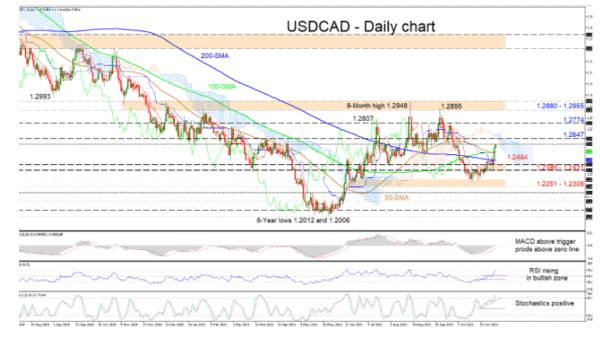USDCAD is exhibiting a more optimistic outlook however, this is being tested by the 1.2600 handle, which has managed to curb additional gains from unfolding. Overall, the simple moving averages (SMAs) have converged and are relatively flat, suggesting the pair may adhere to a neutral trend.
The Ichimoku lines are not demonstrating strong directional momentum even though the red Tenkan-sen line has overstepped the blue Kijun-sen line, while the short-term oscillators are leaning more to the upside. The MACD, which is strengthening above its red trigger line, has nudged above the zero mark, while the RSI is climbing in the bullish region. The strong positive charge in the stochastic oscillator is further promoting the bullish trajectory in the pair.
In the positive scenario, immediate upside constraints could stem from the 1.2600 hurdle ahead of the nearby Ichimoku cloud and the 1.2647 high. Overcoming the cloud, buyers may then encounter the next deterrence around the 1.2774 barrier. Successfully surpassing this too, the resistance border of 1.2880-1.2955, which has held since mid-November 2020 could come under fire.
If the 1.2600 mark curbs advances, initial support may develop in the vicinity of the merged 50- and 100-day SMAs at 1.2539. Dipping below these averages, the red Tenkan-sen line at 1.2484 and the adjacent 200-day SMA at 1.2469 could step into the spotlight. If selling interest intensifies, the nearby boundary of 1.2386-1.2431 may delay the drop in the pair from challenging the 1.2251-1.2308 support base.
Summarizing, USDCAD is sustaining a neutral-to-bullish tone above the SMAs and the 1.2386 low. For the positive bias to strengthen in the short-term timeframe, the price would need to overshoot the 1.2600 level, the cloud and the 1.2774 high. A break above the 1.2880-1.2955 borde r could feed optimism in the medium-term picture.
r could feed optimism in the medium-term picture.


 Signal2forex.com - Best Forex robots and signals
Signal2forex.com - Best Forex robots and signals




